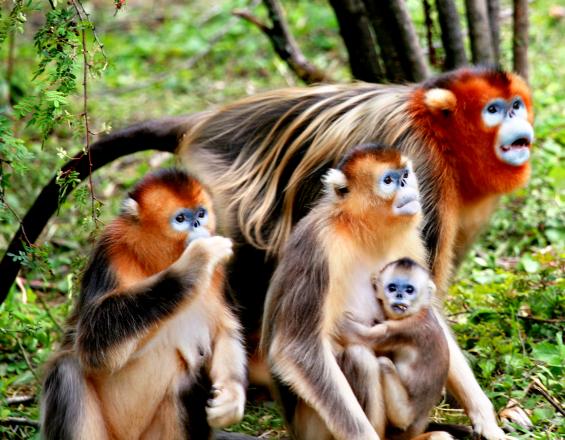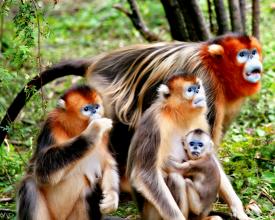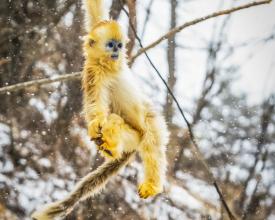
Conservación del mono narigudo dorado mediante la investigación y la educación

Para proteger eficazmente al mono narigudo dorado y otras especies, el Parque Nacional de Shennongjia ha tomado medidas de conservación basadas en la investigación y la educación. El Parque atrajo a un grupo de monos para la investigación basada en la habituación, proporcionándoles comida en un invierno de escasez de alimentos. El Parque construyó una serie de plataformas de investigación abiertas (Base de Investigación de Campo del Mono Narizona Dorado de Shennongjia de la Administración Estatal de Silvicultura, etc.), proporcionó suficiente apoyo logístico y financiero, y se dio a conocer a la comunidad académica por la investigación realizada sobre las especies del parque en cooperación con universidades e instituciones de investigación. Los logros de la investigación se han utilizado para la educación científica popular con el fin de promover la conservación de las especies raras y amenazadas. El Parque construyó centros de exposición para mostrar imágenes, materiales, artículos de divulgación científica y vídeos en directo de las especies para que los visitantes en general puedan ver a los monos sin molestarlos.
Contexto
Défis à relever
1. La falta de personal investigador profesional.
2. Las dificultades para rastrear y realizar estudios de campo sobre el mono hocicudo dorado.
3. El invierno en Shennongjia es frío y largo, y el hábitat está cubierto de nieve durante mucho tiempo, lo que dificulta la búsqueda de alimento para los animales salvajes, incluido el mono narigudo dorado. La reposición artificial de alimentos reduce eficazmente la inanición en invierno.
4. Es necesario mejorar la investigación sobre factores clave como las restricciones de supervivencia, la evaluación sobre el statu quo del hábitat, la nutrición y la diversidad genética.
5. Escasa concienciación del público en general sobre la especie y su conservación. Algunos lugareños ni siquiera conocían la existencia de una especie tan rara y amenazada. La construcción de carreteras provocó la fragmentación de su hábitat. Actividades humanas como la tala, el pastoreo, la recolección de hierbas medicinales, la caza furtiva y el turismo amenazaban a la especie y su hábitat.
Ubicación
Procesar
Resumen del proceso
La investigación basada en la habituación resolvió el problema del cuello de botella relacionado con la investigación de la especie. En cuanto a la investigación de campo, existen muchas dificultades para el rastreo, la realización de identificaciones, el muestreo no destructivo, la observación no perturbadora, etc. Un grupo de monos indiferente a las perturbaciones humanas y que pueda ser observado de cerca es sin duda un objeto ideal para la investigación. El éxito de la habituación resolvió perfectamente los problemas y sentó las bases de una plataforma de investigación. Una buena investigación no sólo atrae la atención de las autoridades superiores y del público, aporta más apoyo financiero para la conservación, sino que también proporciona un buen material para la educación científica popular y la concienciación del público.
Como especie endémica de China, el mono narigudo dorado goza del favor de los investigadores y, por su rareza, elegancia y belleza, resulta muy atractivo para el público y los medios de comunicación. Una buena conservación e investigación de la especie daría lugar sin duda a una reacción en cadena y a un círculo virtuoso de conservación e investigación científica.
Bloques de construcción
Investigación basada en la habituación
Antes de 2005, la reserva natural sólo era capaz de realizar investigaciones preliminares en cooperación con unas pocas instituciones y universidades. El mono narigudo dorado es una especie endémica de China muy apreciada por los investigadores y, por su rareza, elegancia y belleza, resulta muy atractiva para el público y los medios de comunicación. Una buena conservación e investigación de la especie daría lugar sin duda a una reacción en cadena y a un círculo virtuoso de conservación e investigación científica. Basándose en la experiencia adquirida en otras áreas protegidas, el Director General decidió crear un equipo especial para rastrear y observar la especie las 24 horas del día con el fin de obtener datos de primera mano para futuras investigaciones.
En 2005, el nuevo equipo emprendió el largo y difícil camino del "rastreo de monos" con equipos y suministros pesados. Con más de 400 días de esfuerzo, el equipo consiguió reducir la vigilancia natural de un grupo de monos contra el ser humano: ya no temían a los seguidores humanos y empezaron a aceptar la comida que se les ofrecía en el invierno de escasez de alimentos. La armonía entre los humanos y los monos empezó a crecer. Ahora, este grupo de monos se muestra indiferente a las actividades del personal investigador. Los abundantes datos adquiridos han ayudado a los investigadores a aprender sobre la especie. Este método se denomina investigación basada en la habituación.
Factores facilitadores
1. Se facultó a una dirección visionaria para decidir la orientación de la investigación y el presupuesto.
2. Se aprendieron buenas experiencias de investigación de otras áreas protegidas.
3. Se proporcionaron fondos suficientes para apoyar los viajes de aprendizaje y el trabajo de campo del equipo.
4. Un equipo de investigación entusiasta garantizó la eficacia del esfuerzo.
Lección aprendida
1. Al principio, el equipo de investigación debe ser pequeño y estar formado por unos pocos miembros.
2. El equipo de investigación tiene que ser paciente, seguir el rastro de la especie y acercarse a ella poco a poco.
3. Una vez que los monos se familiaricen con los miembros del equipo y sepan que no pretenden hacerles daño, empezarán a aceptar la comida que se les dé y se volverán indiferentes a las actividades de los miembros del equipo.
4. Los datos frescos ayudan al equipo de investigación a aprender más sobre la especie.
5. Una vez establecida la confianza entre los monos y los investigadores, éstos pueden tener un contacto muy estrecho con los monos (normalmente dos veces al día). Sin embargo, antes de entrar en contacto con los monos, los investigadores tienen que recibir desinfección (caminando sobre una alfombra desinfectante y a través de un paso ultravioleta, etc.) y llevar uniforme desinfectado durante el contacto para evitar infecciones cruzadas.
6. El mono narigudo dorado es una especie muy despierta. Este método de investigación basado en la habituación puede aplicarse a otras especies de animales salvajes que estén alerta y a las que sea difícil acercarse.
Crear una plataforma de investigación
La Administración dio prioridad a los gastos de conservación e investigación del mono narigudo dorado, envió a su personal técnico a asistir a conferencias académicas y cursos de formación, celebró el primer Foro Nacional sobre Conservación e Investigación del Mono Narizuda Dorado, acogió conferencias académicas y talleres, incluida la reunión anual de expertos en primates, y reforzó la comunicación con el Departamento Provincial de Ciencia y Tecnología, el Departamento Provincial de Silvicultura y el Ministerio Estatal de Ciencia y Tecnología, etc. para obtener más apoyo financiero y técnico. Desde 2007, se han establecido una serie de plataformas de investigación, como el Centro de Conservación e Investigación del Mono Narizón Dorado de la provincia de Hubei, la Base de Investigación de Campo del Mono Narizón Dorado de Shennongjia de la Administración Estatal de Silvicultura, el Laboratorio Clave Provincial de Hubei para la Biología de la Conservación del Mono Narizón Dorado.
Atraídos por las plataformas de investigación y la promoción de los medios de comunicación, muchos investigadores han acudido en masa a Shennongjia en busca de cooperación en la investigación. La composición y el nivel académico del equipo de investigación, así como sus métodos y tecnología de investigación, han mejorado notablemente.
Factores facilitadores
Dar prioridad a los gastos de conservación e investigación del mono narigudo dorado, enviar personal técnico a conferencias académicas y cursos de formación, celebrar el primer Foro Nacional sobre Conservación e Investigación del Mono Narizuda Dorado, acoger conferencias académicas y talleres, incluida la reunión anual de expertos en primates, y reforzar la comunicación con las autoridades superiores para obtener más apoyo financiero y técnico.
Lección aprendida
Para tener éxito, una plataforma de investigación tiene que ser atractiva, abierta, suficientemente dotada de apoyo logístico y financiero, y conocida por la comunidad académica y el público en general.
Fomento de la sensibilización pública
Desde 2006, se han publicado más de 100 artículos de investigación sobre el mono narigudo dorado en revistas académicas, 30 artículos se incluyeron en el Scientific Citation Index y 2 artículos se publicaron en Nature. Se han adquirido cinco patentes nacionales, se han publicado seis libros y tres logros han ganado el premio provincial al progreso en ciencia y tecnología.
Cada año, más de 5.000 estudiantes universitarios e investigadores visitan la Base de Investigación para hacer prácticas o investigar. Se construyeron centros de exposición para mostrar imágenes, materiales, artículos de divulgación científica y vídeos en directo de la especie para que los visitantes puedan ver a los monos sin molestarlos. La especie se incluyó en la lista de los 10 animales más importantes de las noticias en 2009, muchas fotos han ganado premios nacionales e internacionales de fotografía, famosos documentales han realizado tomas en Shennongjia y docenas de grandes medios de comunicación han publicado reportajes sobre la especie.
La población local es ahora muy consciente de la importancia de la especie y las actividades humanas que amenazan el hábitat se han reducido considerablemente, muchos lugareños y visitantes se han convertido en voluntarios y se han recibido donaciones para la conservación de la especie. La población de la especie y la superficie de su hábitat han aumentado considerablemente.
Factores facilitadores
Publicar los resultados de las investigaciones para promover las especies y su conservación, invitar a los medios de comunicación a contar las historias y utilizar los resultados de las investigaciones para la divulgación científica, con el fin de sensibilizar al público sobre las especies y su conservación.
Lección aprendida
1. Los logros de la investigación deben transformarse en materiales de divulgación científica fáciles de entender.
2. La base de investigación no debe estar abierta a los turistas en general. Sólo los investigadores, los grupos de viaje de estudios y el personal de los medios de comunicación pueden entrar en la base después de desinfectarla. Todos los visitantes deben llevar ropa desinfectada y permanecer en el sendero para mantener la distancia con los monos.
3. Los visitantes con los que los monos de la base no estén familiarizados no podrán tocarlos.
4. Debe controlarse el número de visitantes y exigirles que guarden silencio para que los monos no se asusten.
Impactos
Se ha mejorado la composición y el nivel académico del equipo de investigación, así como sus métodos y tecnología de investigación. Esto ha atraído más la atención de las autoridades provinciales y nacionales y ha ganado más políticas preferenciales y apoyo financiero. Cada año, más de 5.000 estudiantes universitarios e investigadores visitan la Base de Investigación para hacer prácticas o investigar, y la Base está abierta a grupos de viaje de estudios de estudiantes escolares y voluntarios. La especie se incluyó en la lista de los 10 animales más populares de las noticias de 2009, muchas fotos han ganado premios nacionales e internacionales de fotografía, famosos documentales como Nacido en China, China salvaje y Siete planetas, un mundo, etc. han realizado tomas en Shennongjia, y docenas de medios de comunicación nacionales han publicado reportajes sobre la especie. Se ha convertido en una celebridad y Shennongjia se está poniendo a la cabeza de la educación científica popular sobre la especie. Los logros de la investigación y la promoción de la concienciación han ayudado mucho a la correcta conservación de la especie: los lugareños son muy conscientes de la importancia de la especie y las actividades humanas que amenazan su hábitat se han reducido mucho, muchos lugareños y visitantes se han convertido en voluntarios y se han recibido donativos para su conservación. La población de la especie (unos 800 ejemplares en 2005) ha aumentado a 1.471 y la superficie de su hábitat (143 kilómetros cuadrados) se ha ampliado a 354 kilómetros cuadrados.
Beneficiarios
- Parque Nacional de Shennongjia;
- Instituto de Investigación Científica del Parque Nacional de Shennongjia;
- Reserva del Hombre y la Biosfera de Shennongjia;
- Geoparque Mundial de la UNESCO de Shennongjia;
- Sitio Natural del Patrimonio Mundial de Hubei Shennongjia
Objetivos de Desarrollo Sostenible
Historia
Antes de 2005, la reserva natural era muy débil en investigación científica y sólo era capaz de realizar investigaciones preliminares en cooperación con unas pocas instituciones y universidades. Mientras tanto, la investigación para la conservación de la vida salvaje se había desarrollado vigorosamente en las reservas naturales chinas y se habían publicado muchos casos de éxito. Aunque Shennongjia está dotada de abundantes recursos, permanecía silenciosa y desconocida para el público. En tales condiciones, el Sr. Liao Mingyao, Director General de la Administración de la Reserva Natural Nacional de Shennongjia (integrada en el Parque Nacional de Shennongjia en 2015) decidió hacer más, con el mono narigudo dorado como gran avance.
El Director General y su equipo consultaron a expertos de instituciones de investigación y universidades, y visitaron organizaciones de conservación e investigación de Sichuan, Yunnan y Shaanxi para conocer su experiencia. A su regreso, tomó una decisión primordial pero audaz: crear un equipo especial para rastrear y observar al mono narigudo dorado las veinticuatro horas del día y obtener datos de primera mano sobre la especie. La decisión resultó sabia y clarividente. Como especie endémica de China, el mono narigudo dorado goza del favor de los investigadores y, por su rareza, elegancia y belleza, resulta muy atractivo para el público y los medios de comunicación. Una buena conservación e investigación de la especie daría lugar sin duda a una reacción en cadena y a un círculo virtuoso de conservación e investigación científica.
En abril de 2005, el nuevo equipo comenzó el largo y difícil camino de "rastreo de monos" con equipo pesado y suministros. Los senderos de montaña eran peligrosamente empinados, el tiempo cambiante, la selva primitiva densa, los monos despiertos escapaban en cuanto veían a un humano... Eran demasiadas dificultades. Con más de 400 días de esfuerzo, el equipo consiguió reducir la vigilancia natural de un grupo de monos contra el ser humano: ya no temían a los seguidores humanos y empezaron a aceptar la comida que se les ofrecía en el invierno de escasez de alimentos. La armonía entre los humanos y los monos empezó a crecer. Ahora, este grupo de monos es indiferente a las actividades del personal de investigación. Este método se denomina investigación basada en la habituación.
En 2019, la Administración aportó 3 millones de CNY (unos 428.600 USD) para apoyar el trabajo de campo de los mejores equipos de investigación de China, y estableció una fundación para la conservación de esta especie y su hábitat, que ha recibido donaciones por valor de 4 millones de CNY (unos 571.000 USD).

